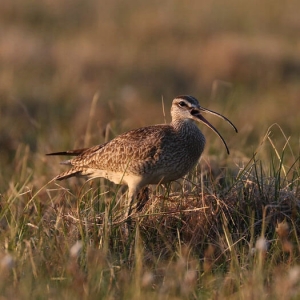Climate Change
Climate change is happening now.
With shorebirds’ reliance on coastal wetlands, the Arctic tundra, saline lakes in arid regions, and highly specified food resources to complete their annual cycles, they are extremely vulnerable to the changes that are occurring, such as:
- Loss of habitat due to rising tides
- Hotter and drier conditions in some regions
- Shrub encroachment on nesting habitat in a warming Arctic
- Mismatched timing of migration and availability of food resources
Of 52 shorebird species that regularly breed in North America, 90% are predicted to experience an increase in risk of extinction. This includes 28 species already considered at high risk of extinction, and 10 imperiled species that face even further increased risk.*
* Source: Predicting Vulnerabilities of North American Shorebirds to Climate Change.
Galbraith H, DesRochers DW, Brown S, Reed JM (2014) Predicting Vulnerabilities of North American Shorebirds to Climate Change. PLOS ONE 9(9): e108899.
Assessing Climate Change
The Climate Change Vulnerability Assessment for Shorebird Habitat (CCVASH), Coastal Version, is an Excel workbook-based tool designed to help managers make informed decisions about shorebird management, for habitats and species, relative to climate change effects. The CCVASH guides participants through several worksheets and exercises to help them assess the vulnerability of coastal shorebird habitats to climate change, using three categories:
- Effects of sea-level rise;
- Effects of other climate-change variables, such as predicted changes in temperature and precipitation; and
- Effects of increased frequency and intensity of storms.
Once the vulnerability is measured, the assessment outlines explicit strategies and adaptation options, and evaluates each option’s chances for success.
The assessment may be completed entirely or partially in a workshop format, with participation from site staff, partners, and stakeholders. These participants could include representatives from federal agencies, state agencies, private non-profit organizations, academic institutions, research organizations, and volunteers familiar with the site. It is extremely useful to get subject matter experts to participate, such as experts in shorebird species, marsh accretion, dynamic coastal systems, geomorphology, invasive species, and so forth. By inviting the participation of all partners and stakeholders, the site will benefit two-fold: first, from the breadth of knowledge they contribute and, second, by the opportunity to educate and engage them, encouraging further collaboration.
Click here to download the full instructions for using the CCVASH Tool, Coastal Version.
To download the CCVASH Excel workbook and begin using the tool, click here.
Resources
The WHSRN Executive Office has compiled the following list of resources to inform and guide your site’s planning process for climate change adaptation and mitigation. Do you know of a helpful resource on climate change adaptation and mitigation for shorebird habitat? We encourage you to share new research, case studies, models, and planning tools. Contact us to contribute to this list.
- ALiVE: Adaptation, Livelihoods and Ecosystems Planning Tool: a user-friendly computer-based EbA planning tool to support adaptation practitioners in organizing and analyzing information to plan feasible and effective EbA options.
- IUCN Briefing on Ecosystem-based Adaptation: What is the issue? Why is it important? And what can be done?
- AdaptationCommunity.net: this website was developed for “the interested public and adaptation experts to provide information on applying approaches, methods and tools that facilitate the planning and implementation of adaptation action. Furthermore, enhancing knowledge and sharing experience is the key to successful adaptation strategies.” View their full array of webinars, trainings, and information here and find their deep-dive into Ecosystem-based Adaptation here.
- BirdLife International: Using Adaptive Management to Reduce the Impact of Climate Change on Biodiversity.
- BirdLife International: Ecosystem-based approaches for adaptation and impacts of adaptation activities on biodiversity.
- Climate Action Plan for the Americas: This continent-wide scientific analysis, led by Audubon, BirdLife, and Durham University, “unites partners in 12 countries to deliver nature-based solutions that increase the climate resilience of people and biodiversity throughout Latin America and the Caribbean, while supporting carbon sequestration and storage.”
- Psychology of Climate Change Communication: A Guide for Scientists, Journalists, Educators, Political Aides, and the Interested Public, by the Center for Research on Environmental Decisions (CRED) at Columbia University.
- Climate Change Vulnerability Assessment Tool for Coastal Habitats (CCVATCH): Download the Guidance Document, Excel scoring workbook, and facilitation materials, and explore these links of web-based tools and data sources for assessments.

Join the Conversation
As shorebird scientists, land managers, and conservationists, we are facing an urgent need to adapt to climate change to ensure shorebird populations and human communities can thrive at our sites into the future. To offer advice, case studies, and ideas to your fellow WHSRN site partners and ask questions of the wider shorebird conservation community, participate in the Climate Change discussion on the Shorebird Forum. This is a space to discuss strategies for climate change adaptation and mitigation, and share advice for navigating the many tools and resources available to assist with this process.
All photos: Shiloh Schulte.




